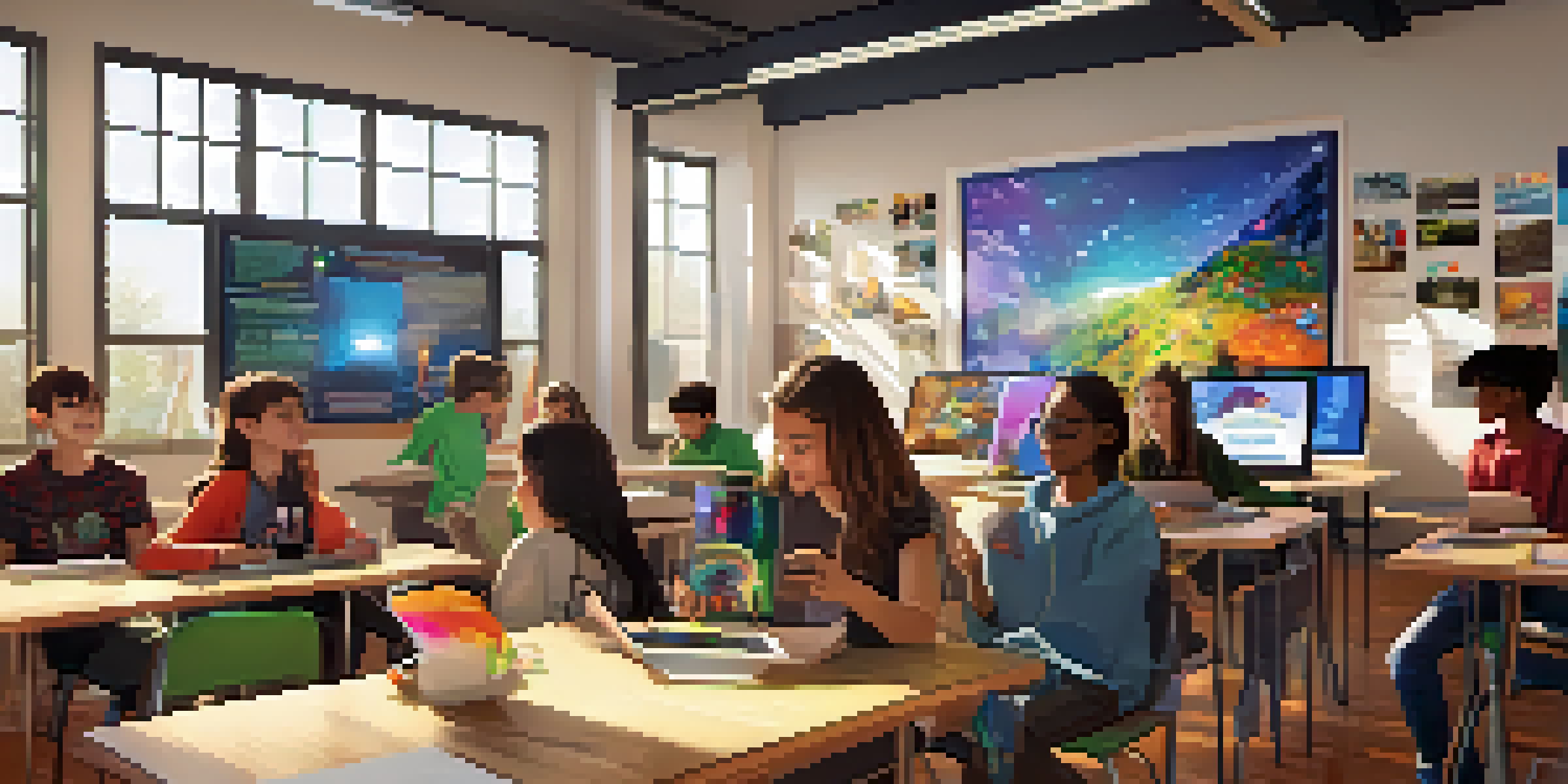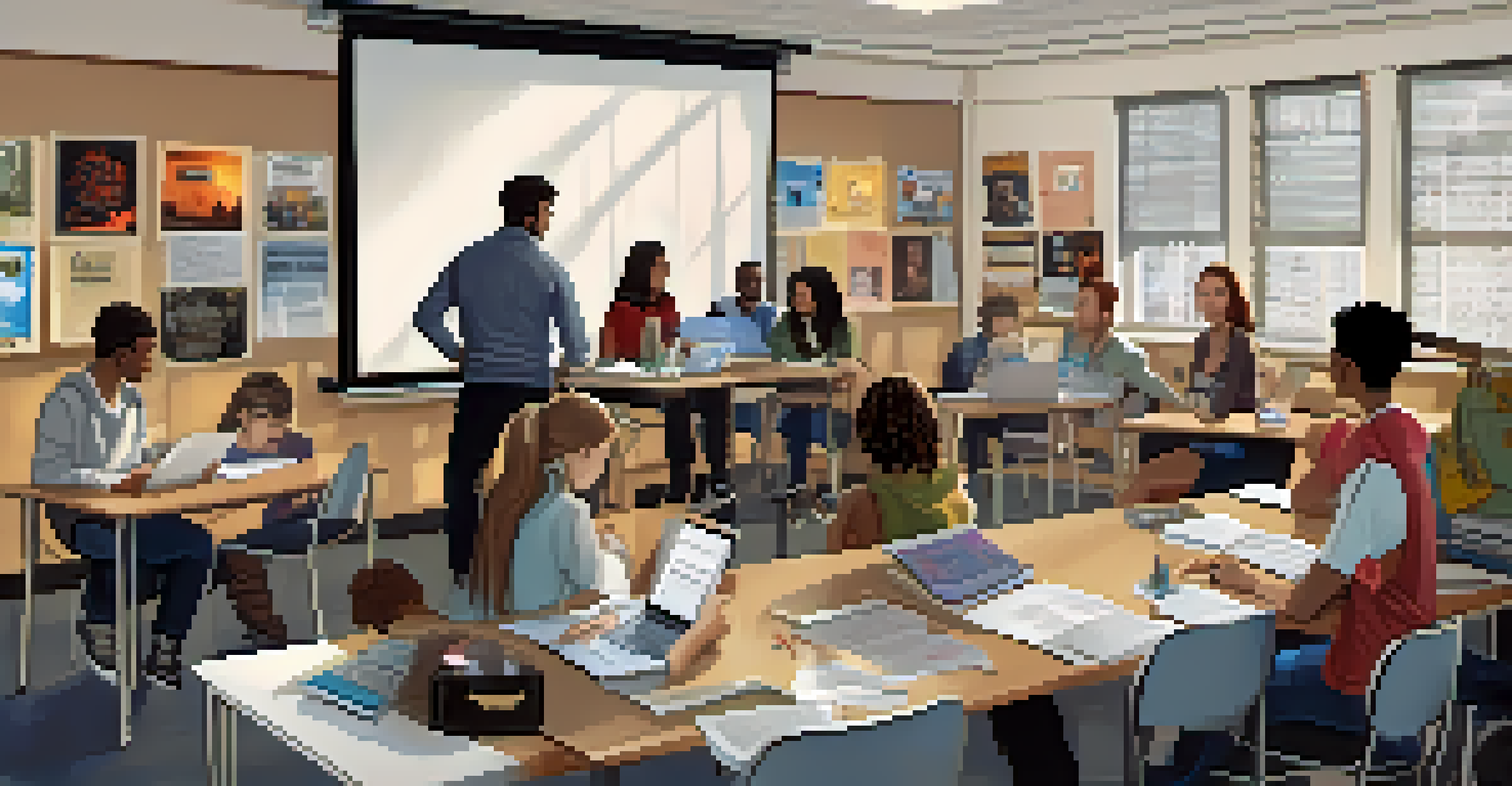Transmedia Learning: Connecting Theory with Practice

Understanding Transmedia Learning in Education
Transmedia learning refers to an educational approach that utilizes multiple media platforms to enhance the learning experience. This method goes beyond traditional teaching by integrating storytelling, digital media, and interactive elements to engage students. By appealing to various learning styles, transmedia learning can make complex subjects more accessible and enjoyable.
Learning is not the product of teaching. Learning is the product of the activity of learners.
Imagine a classroom where students can explore historical events not just through textbooks but through interactive websites, videos, and virtual reality experiences. This multifaceted approach can help students grasp the nuances of a subject by allowing them to experience it from different angles. In this way, transmedia learning creates a richer educational tapestry that students can immerse themselves in.
Essentially, transmedia learning transforms passive learning into an active exploration, encouraging students to take charge of their educational journey. As technology continues to evolve, this approach not only prepares students for the future but also fosters critical thinking and creativity. In the following sections, we’ll delve deeper into the theories behind transmedia learning and its practical applications.
Theoretical Foundations of Transmedia Learning
At its core, transmedia learning draws on several educational theories, including constructivism and multiple intelligences. Constructivism posits that learners build knowledge through experiences, while Howard Gardner's theory of multiple intelligences suggests that individuals learn in various ways. By combining these theories, transmedia learning creates a holistic educational experience that caters to diverse learners.

For example, a student who struggles with traditional reading may excel when engaging with a video or interactive game that presents the same information. This adaptability not only helps students understand the material better but also boosts their confidence. The foundation of transmedia learning lies in its ability to cater to individual learning styles, making education more inclusive.
Transmedia Learning Enhances Engagement
By integrating various media platforms, transmedia learning captivates students' attention and fosters a deeper interest in the subject matter.
Furthermore, the use of transmedia storytelling allows learners to engage with narratives across different platforms, deepening their understanding. When students can connect with a story through books, films, and interactive media, they are more likely to retain information and develop a passion for the subject matter. This interconnectedness of media not only enhances comprehension but also encourages creativity.
Practical Applications of Transmedia Learning
In practice, transmedia learning can take many forms, from educational games to immersive simulations. For instance, a history lesson might include a documentary film, an interactive timeline, and a virtual reality experience that transports students to significant historical events. This variety of formats allows students to engage with the material in a way that resonates with them personally.
The only way to learn mathematics is to do mathematics.
A great example of transmedia learning in action is the 'Hunger Games' educational project, where students analyze the themes of the book through films, online discussions, and social media platforms. This project encourages critical thinking and collaboration, as students draw connections between different media and share their insights. By doing so, they not only expand their understanding but also learn to articulate their viewpoints effectively.
Moreover, educators can leverage transmedia learning to address real-world issues, such as climate change or social justice. By engaging students in projects that require them to research, create, and share across various platforms, they develop a sense of agency and responsibility. This hands-on approach not only enhances learning but also empowers students to become active participants in their communities.
Benefits of Transmedia Learning for Students
Transmedia learning offers numerous benefits for students, including increased engagement and motivation. When students encounter educational content through diverse media, they are more likely to stay interested and invested in their learning. This dynamic approach fosters a sense of curiosity, encouraging students to explore topics beyond the classroom material.
Additionally, transmedia learning promotes collaboration and communication among peers. Working on group projects that utilize different media allows students to share their strengths and learn from one another. This collaborative environment not only builds teamwork skills but also nurtures a sense of community within the classroom.
Diverse Learning Styles Supported
Transmedia learning accommodates different learning preferences, allowing students to engage with content in ways that resonate with them individually.
Finally, transmedia learning helps students develop critical thinking and problem-solving skills. By navigating various media formats and synthesizing information from multiple sources, students learn to analyze content critically and formulate their own opinions. These skills are invaluable, not just in academic settings but in their future careers and everyday lives.
Challenges in Implementing Transmedia Learning
While transmedia learning has many advantages, it also presents unique challenges for educators. One significant hurdle is the need for adequate resources, including access to technology and diverse media content. Without the necessary tools, teachers may struggle to create effective transmedia learning experiences that engage students fully.
Another challenge is the potential for information overload. With so many media platforms and content types available, students might feel overwhelmed by the sheer volume of information. Educators need to strike a balance between providing enough resources to foster exploration and ensuring that students can manage the content without feeling lost.
Lastly, teachers may require additional training to effectively implement transmedia learning strategies in their classrooms. Professional development opportunities focused on digital literacy and transmedia storytelling can empower educators to navigate this innovative approach confidently. By equipping teachers with the right skills, we can ensure that transmedia learning reaches its full potential in the classroom.
Future Trends in Transmedia Learning
As technology continues to evolve, the future of transmedia learning looks promising. One trend is the increasing integration of artificial intelligence (AI) in educational settings. AI can provide personalized learning experiences, adapting content to meet the individual needs of students and enhancing engagement through tailored recommendations.
Moreover, the rise of virtual and augmented reality is set to revolutionize the transmedia learning landscape. These immersive technologies allow students to explore complex concepts in a hands-on way, making learning more impactful and memorable. Imagine a biology class where students can virtually dissect a frog or explore the human body in 3D—these experiences can significantly deepen understanding.
Future Trends Embrace Technology
The integration of AI and immersive technologies like virtual reality is set to revolutionize transmedia learning, creating more personalized and impactful educational experiences.
Finally, as educators continue to embrace transmedia learning, collaboration among institutions will likely increase. Sharing resources and best practices can lead to the development of innovative curricula that harness the power of multiple media platforms. This collaborative spirit can foster a vibrant educational community that supports both teachers and students in their learning journeys.
Conclusion: Embracing Transmedia Learning
In conclusion, transmedia learning represents a powerful approach to education that connects theory with practice. By utilizing various media platforms, educators can create engaging and meaningful learning experiences that cater to diverse learners. This method not only enriches the educational landscape but also prepares students for a rapidly changing world.
As we continue to explore the potential of transmedia learning, it is essential to address the challenges and invest in resources that support its implementation. By equipping educators with the necessary tools and training, we can unlock the full potential of this innovative approach. The future of education is bright, and transmedia learning is at the forefront of this transformation.

Ultimately, embracing transmedia learning means fostering a culture of curiosity, creativity, and collaboration in our classrooms. As we empower students to explore and learn across multiple platforms, we prepare them not just for academic success, but for lifelong learning and engagement in their communities.